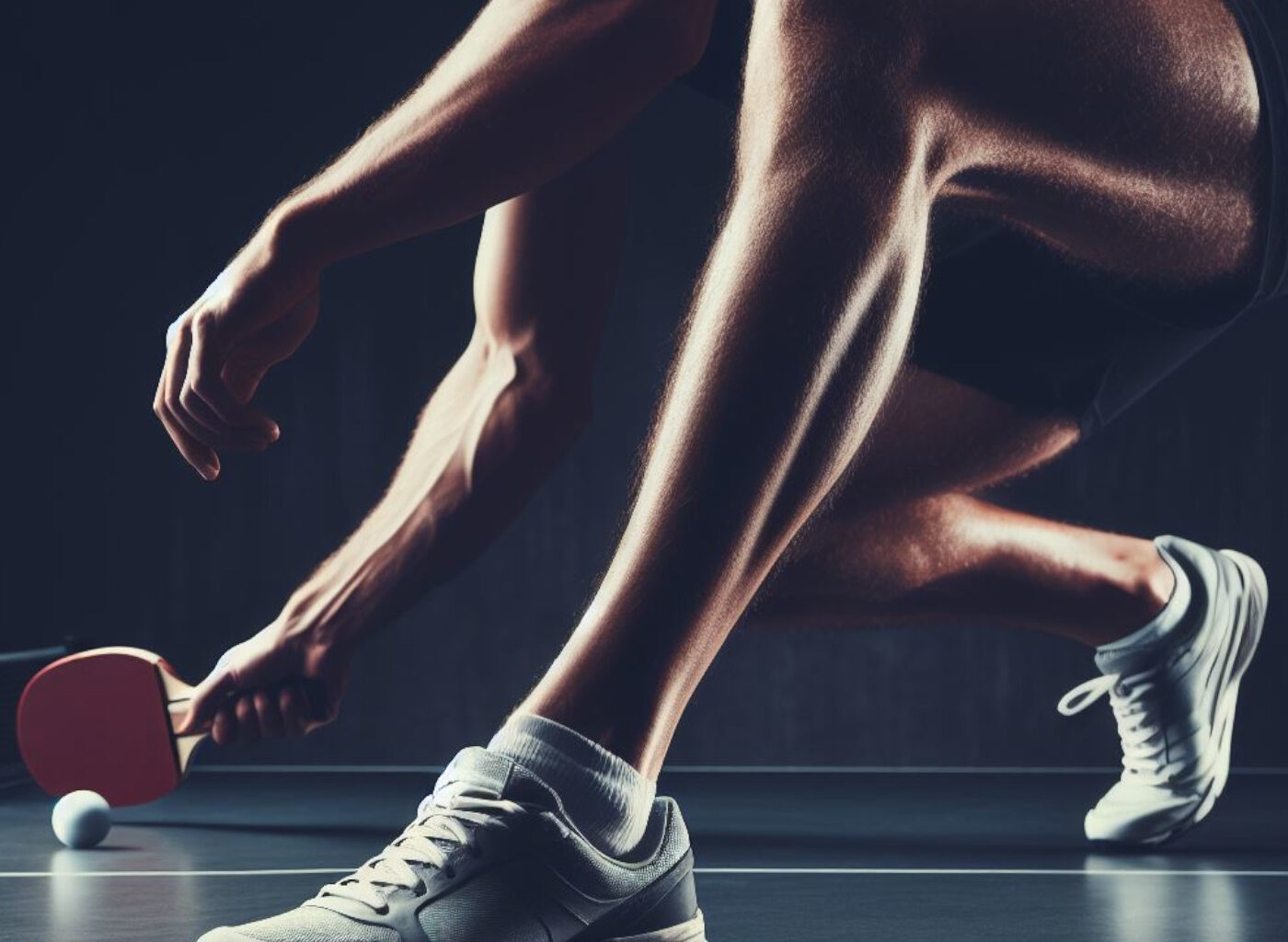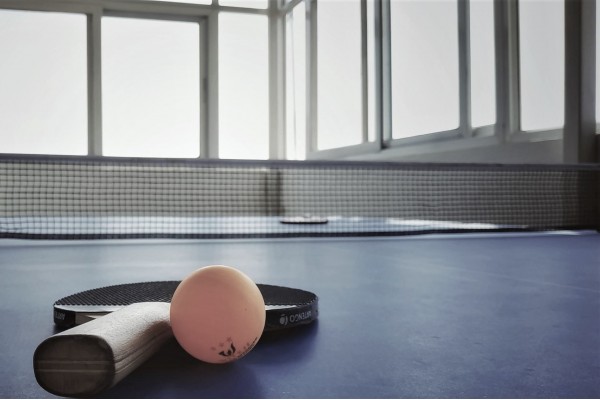

The basis of success
How important are legs in table tennis? Read on instead. Table tennis, as a demanding Olympic discipline, requires much more than just hand agility and keen vision. In this universe where every millisecond counts, the legs emerge as the fundamental element, the cornerstone on which a player’s performance is based.
Far beyond simple appendages, legs orchestrate the symphony of mobility, balance, power and speed, shaping the game from start to finish. This article will explore in depth the crucial importance of the legs in table tennis, shedding light on how these often underestimated limbs are the key to success in this exhilarating sport.
Mobility and Positioning thanks to the legs in table tennis
At the heart of success in table tennis lies the player’s ability to move with flawless agility. He must also adopt strategic positions in the blink of an eye. It is in this incessant dance around the table that the legs play a major role.
Agility and Responsiveness
The legs, acting as powerful thrusters, allow the player to respond with impressive speed to the often unpredictable trajectories of the ball. Lateral movements, sudden sprints forward or backward, all depend on leg mobility. Well-developed agility is the key to reaching the ideal position and anticipating opponent’s moves.
Instant Changes of Direction
Table tennis is a frenetic ballet where every movement counts. The legs, acting as dynamic pivots, allow the player to change direction in a flash. The ability to slide from one corner of the table to the other, to quickly adjust to the unexpected, relies on flexibility and coordination of the legs.
The Basis of Precision
The precision of table tennis shots is a direct result of the stability offered by the legs. By ensuring a solid anchorage to the ground, the legs allow the player to maintain adequate posture, a fundamental element for precise shots. The quality of leg positioning determines the quality of the strike, transforming a simple riposte into a precise attack.
So, in this section, we have shed light on how leg mobility, agility, and their ability to enable rapid changes of direction are essential elements for any table tennis player looking to excel in their art. The remainder of this post will explore other crucial facets of the importance of the legs in this demanding sport.
Balance and Stability
Amidst the whirlwind of rapid rallies and precise balls in table tennis, balance and stability emerge as essential elements, dictating the quality of execution of each movement and shot.
Foundations of Balance
The legs, through their ability to maintain the player’s center of gravity, are the architects of his balance. A balanced posture, achieved through firm and well-anchored legs, is crucial to confront the varied trajectories of opposing balls. A balanced posture, achieved through firm and well-anchored legs, is crucial to confront the varied trajectories of opposing balls.
Stability for Precise Responses
During fast and intense exchanges, leg stability is a determining factor for a precise response. Strong legs provide an unshakable foundation, allowing the player to maintain control over their racket and adjust ball trajectory with precision. It is in this stability that the key to transforming a simple reaction into a strategic response lies.
Reinforced Anticipation
Increased stability through well-trained legs also improves the player’s ability to anticipate the opponent’s actions. By maintaining a solid foundation, the player can react more quickly to changes in ball direction, thereby gaining a tactical advantage. Balance and stability of the legs allow the player to adopt optimal positions for each shot, thus optimizing their chances of success.
This section highlights the critical importance of balance and leg stability in the context of table tennis. These qualities are not simply physical assets, but essential foundations that underpin the player’s overall performance. The next section will explore the legs’ contribution to power and speed.
Power and Speed
In table tennis, the ability to generate explosive power and react with lightning speed are key factors in dominating your opponent and dictating the pace of the game. Thus, we will explore in depth the way in which the legs, like dynamic machines, fuel the power of the blows and the speed of execution.
Power Transmission
The power of table tennis shots comes from the efficient transfer of body weight through the legs. The leg muscles, particularly the quadriceps and glutes, are the engines that propel the player forward during the attack. The coordinated movement of the legs and trunk ensures optimal energy transfer. In this way the player transforms each shot into a demonstration of controlled power.
Agility and Speed of Execution
Speed of execution in table tennis is often the key to success. Agile legs allow the player to move quickly around the table. They also allow you to react instantly to opposing balls and adopt optimal positions for each shot. Small adjustments made through well-developed agility can make the difference between a successful response and a lost opportunity.
Dynamic coordination between the trunk and legs in table tennis
Harmonious coordination between the legs and upper body is essential for maximum power and speed. During powerful strokes, trunk rotation, combined with synchronized leg flexion and extension, creates dynamic coordination. This coordination allows the player to unleash explosive power. It also allows us to maintain the speed necessary to anticipate and respond to adverse actions.
It is clear that power and speed in table tennis are closely related to leg performance. A deep understanding of how the legs act as catalysts for these key elements can significantly improve a player’s strategy and effectiveness. The final section will look at endurance. She will highlight how well-conditioned legs maintain performance at its highest level throughout a match.
Endurance and legs in Table Tennis
Every exchange in table tennis can turn into an intense physical and mental challenge. This is why endurance emerges as a critical factor that directly influences the consistency and quality of a player’s performance. In this section we will explore the importance of the legs in maintaining endurance throughout a match.
Foundations of Endurance
Table tennis endurance is not simply a matter of cardiorespiratory capacity. Indeed, it also depends on the muscular capacity, in particular of the legs, to maintain an optimal level of performance. Thus, well-conditioned legs are less prone to fatigue. They allow the player to maintain fluid mobility and stable balance. They also provide constant power even in the final stages of a demanding match.
Continuous Mobility
Table tennis requires constant mobility. This mobility aims to move quickly towards the ball, adjust body position, or make quick pivots. Strong legs are then crucial to maintain this mobility throughout a match. Indeed, they ensure that the player remains responsive to the incessant variations of the game.
Persistent Power
Leg endurance also helps maintain punching power throughout a match. As fatigue sets in, well-trained legs allow the player to continue generating effective attacks. The ability to maintain strength until the end of a match can be the difference between victory and defeat.
Sustainable Gaming Strategy
Finally, leg endurance plays a role in overall game strategy. A player with strong legs can take a more proactive approach. He tires the opponent with prolonged rallies and exploits tactical opportunities at key moments. Leg endurance thus allows you to remain faithful to a game strategy throughout the duration of a match.
This section highlights the central role of the legs in maintaining endurance in table tennis. Well-prepared legs guarantee consistent performance. This reduces the risk of a drop in level during crucial phases of a competition. The legs then become essential allies for any player aspiring to excellence in this demanding sport. Indeed, they make it possible to combine continuous mobility, persistent power and a sustainable gaming strategy.
Legs, Essential Pillar of Excellence in Table Tennis
Table tennis, a subtle blend of strategy, speed and precision, reveals its deepest essence through the crucial importance of the legs. Like a well-synchronized orchestra, each movement in table tennis draws its power, speed and balance from an often underestimated source: the player’s legs.
leg mobility in table tennis
In the frenetic dance around the table, the mobility of the legs proves to be the first movement of a successful symphony. Agility, responsiveness, changes of direction, all these nuances depend on the ability of the legs to respond to the opponent’s challenges.
Balance and stability thanks to the legs in table tennis
Balance and stability, the masters of ceremonies of precision, then take over. Balance and stability, the masters of ceremonies of precision, then take over. They then transform the response into a meticulous work of art.
Then, in a crescendo of power and speed, the legs transform into energy generators. Indeed, weight transfer, agility and coordination between the legs and core create explosive force. Additionally, agile legs allow the player to deftly navigate through each exchange.
Endurance and legs in table tennis
Finally, endurance, this ultimate revelation, imposes the legs as the guardians of constancy. Well-trained legs keep mobility, power and playing strategy at an optimal level. And you can count on it even in the toughest moments of a competition.
Thus, the legs emerge as the essential pillar of excellence in table tennis. Their role transcends simple locomotion to become the foundation on which the entire structure of the game rests. For any player aspiring to master this demanding art, leg training becomes an indisputable necessity. In a nutshell, with their ability to combine power, agility, balance and endurance, the legs are the essence of table tennis performance.
Featured image : picture by Mamba Blades “The Capital Importance of Legs in Table Tennis“










